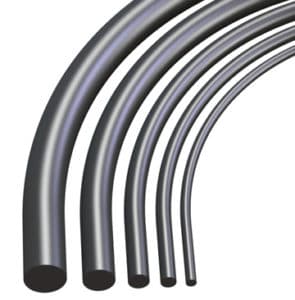3 Classes of O-Ring Cord Tolerances
 Extruded o-ring cord stock is used for a variety of applications whenever a molded o-ring is impractical for one reason or another. The o-ring cord is extruded through a die in a variety of thicknesses or cross-sections.
Extruded o-ring cord stock is used for a variety of applications whenever a molded o-ring is impractical for one reason or another. The o-ring cord is extruded through a die in a variety of thicknesses or cross-sections.
This extrusion process used to make o-ring cord has many advantages, however, it can be difficult to achieve a consistent, precise thickness throughout the length of the cord. Molded o-rings, on the other hand, tend to have very tight cross-sectional tolerances due to the precise manufacturing capabilities of compression or injection molding. Because of this, the Association for Rubber Products Manufacturers (ARPM) has produced industry-accepted standards for the cross-sectional tolerances of extruded rubber o-ring cord.
Note: These standards were previously maintained by the Rubber Manufacturer’s Association (RMA). In 2010, rubber products manufacturers split from the RMA and formed the Association for Rubber Products Manufacturers (ARPM). The data below has been taken from the 7th edition-2015 Rubber Handbook for Molded, Extruded, Lathe-Cut and Cellular Products.
The three classes of tolerances are:
- Class I (E1) – High Precision
- Class 2 (E2) – Precision
- Class 3 (E3) – Commercial
At Global O-Ring and Seal, we require all of our factories to manufacture o-ring cord stock according to the High Precision (E1) tolerances. However, due to the swelling and contracting nature of rubber cord, slight variations in the cross-section dimension are possible over time. Therefore, we guarantee all of the cord we sell will meet the Precision (E2) tolerances. For Viton® cord, our factory tolerances exceed High Precision (E1) specifications, allowing us to sell to High Precision (E1) tolerances. For customers with a specific need for Class E1 or even tighter tolerances, we will do our best to accommodate those needs.
Cross-Sectional Tolerances (Inches)
| Cross Section | E1 | E2 | E3 |
|---|---|---|---|
| .000 – .059 | +/- .006 | +/- .010 | +/- .015 |
| .060 – .099 | +/- .008 | +/- .014 | +/- .020 |
| .100 – .159 | +/- .010 | +/- .016 | +/- .027 |
| .160 – .249 | +/- .014 | +/- .020 | +/- .031 |
| .250 – .389 | +/- .016 | +/- .027 | +/- .039 |
| .390 – .629 | +/- .020 | +/- .031 | +/- .051 |
| .630 – .979 | +/- .027 | +/- .039 | +/- .063 |
| .980 – 1.569 | +/- .031 | +/- .051 | +/- .079 |
| 1.570 – 2.479 | +/- .039 | +/- .063 | +/- .098 |
| ≥ 2.480 | +/- .051 | +/- .079 | +/- .126 |
Cross-Sectional Tolerances (Metric)
| Cross Section | E1 | E2 | E3 |
|---|---|---|---|
| 0.00 – 1.49 | +/- .150 | +/- .250 | +/- .400 |
| 1.50 – 2.49 | +/- .200 | +/- .350 | +/- .500 |
| 2.50 – 3.99 | +/- .250 | +/- .400 | +/- .700 |
| 4.00 – 6.29 | +/- .350 | +/- .500 | +/- .800 |
| 6.30 – 9.99 | +/- .400 | +/- .700 | +/- 1.00 |
| 10.00 – 15.99 | +/- .500 | +/- .800 | +/- 1.30 |
| 16.00 – 24.99 | +/- .700 | +/- 1.00 | +/- 1.60 |
| 25.00 – 39.99 | +/- .800 | +/- 1.30 | +/- 2.00 |
| 40.00 – 62.99 | +/- 1.00 | +/- 1.60 | +/- 2.50 |
| ≥ 63.00 | +/- 1.30 | +/- 2.00 | +/- 3.20 |
Standard Cord Cross Sections and Tolerances
The table below shows all of the common sizes of cord stock that we carry in various materials and durometers. We have listed the tolerances for each size, according to the ARPM Class E2 tolerances from the above chart. Additionally, the table shows the potential smallest and largest cross-sectional dimensions according to these tolerances for that particular size. If your application requires tighter tolerances than these, please be sure to inquire with us before placing an order so we can find an appropriate solution to meet your needs.
| Inch | MM | Common Name | Tolerance | Low | High |
|---|

 English
English  Español
Español  Français
Français  Português
Português  Deutsch
Deutsch  Italiano
Italiano  Русский
Русский  中文
中文  日本語
日本語  العربية
العربية  हिन्दी
हिन्दी